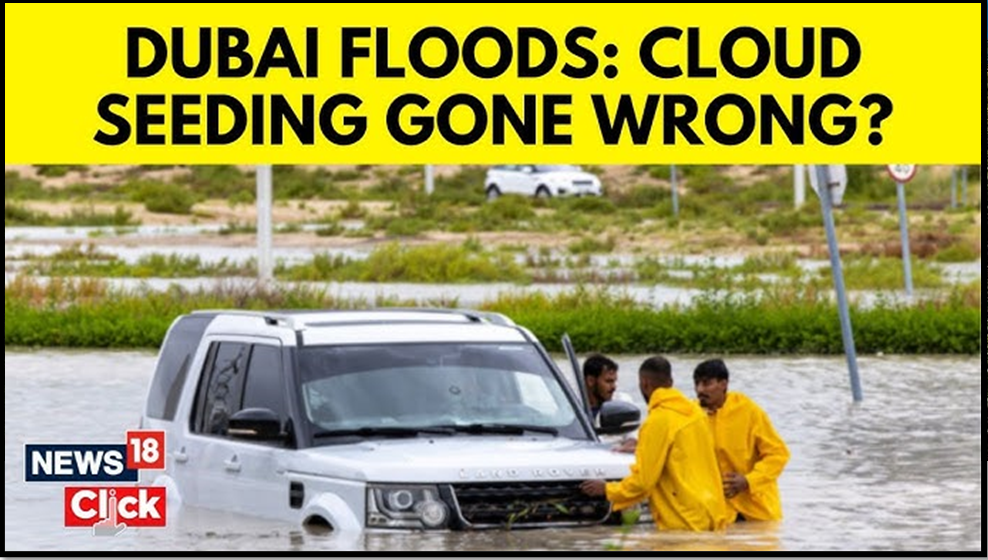RECENT FLASH FLOODS IN DUBAI
Syllabus:
- GS 1: Important Geophysical phenomena such as earthquakes, Tsunami, Volcanic activity, cyclone. etc., geographical features and their location-changes in critical geographical features (including water-bodies and ice-caps) and in flora and fauna and the effects of such changes.
- GS 3: Disaster and disaster management.
Focus:
The recent heavy rainfall event in the United Arab Emirates (UAE), particularly in Dubai, marked a significant departure from the region’s typical arid climate. Check here reasons for Dubai Flood.
Source: Hinduustan Time
What is a Flash Flood?
- Definition: A flash flood is a sudden, intense flood that occurs within hours of excessive rainfall, typically in low-lying areas.
- Cause: Triggered by heavy rainfall or sudden release of water.
- Speed: Develops quickly, leaving little time for preparation.
- Duration: Typically lasts a short period but with substantial impact.
- Danger: Considered extremely dangerous due to the rapid rise of water and potential to carry large debris.
Reasons Behind Recent Flash Floods in Dubai
- Exceptional Rainfall: The area experienced unusually severe rainfall that the drainage systems could not handle.
- Cloud Seeding: While not directly proven, cloud seeding has been discussed as a factor that may increase rainfall intensity, possibly impacting flood severity.
- Inadequate Infrastructure: Existing drainage and water management systems were unable to cope with the sudden influx of water.
- Geographical Vulnerability: Certain areas in Dubai are particularly susceptible to flooding due to their topography and urban layout.
- Climate Variability: The region has faced increased weather variability, which may contribute to the unpredictability and severity of weather events.
| What is Cloud Seeding?
Overview:
Cloud Seeding Methods: 1. Static Cloud Seeding:
2. Dynamic Cloud Seeding:
3. Hygroscopic Cloud Seeding:
|
Other recent major flash floods in Dubai:
- February 12, 2024: Heavy rains caused significant flooding in parts of Dubai, with cars trapped in standing water due to overwhelmed drainage systems .
- November 17, 2023: Severe thunderstorms and flash floods struck Dubai, disrupting the city’s events calendar and causing widespread waterlogging and damage .
Implications of the Floods
- Infrastructure Damage: Significant damage to roads, bridges, and buildings, leading to costly repairs and economic impacts.
- Disruption to Daily Life: Flooding led to traffic disruptions, school closures, and impacted daily commuting and business operations.
- Health and Safety Risks: Standing water poses health risks, including waterborne diseases, and increases the risk of accidents.
- Economic Losses: Businesses suffer losses due to damaged property and disrupted operations.
- Environmental Impact: Flooding can lead to environmental degradation, affecting local ecosystems and wildlife habitats.
Broader Environmental and Climate Considerations:
- Impact of Global Warming: Discuss how rising temperatures can increase the frequency and intensity of extreme weather events, including heavy rainfall.
- Sustainable Urban Planning: Highlight the need for cities to incorporate climate resilience into urban planning.
- Water Resource Management: Examine the challenges and strategies for managing water resources sustainably in arid regions prone to sudden floods.
- Ecosystem Disruption: Consider the impact of urban flooding on local flora and fauna, and the long-term ecological consequences.
- Biodiversity Conservation: Discuss the importance of protecting natural habitats to maintain biodiversity, which can be threatened by urban expansion and climate change.
What Can Be Done?
- Enhance Drainage Systems: Upgrading and expanding drainage systems to handle higher water volumes.
- Implement Strict Building Codes: Enforcing building regulations that require flood mitigation measures in construction practices.
- Develop Emergency Preparedness Plans: Establishing clear emergency response strategies and communication plans for residents.
- Utilize Green Infrastructure: Promoting the use of permeable surfaces and green roofs to increase absorption and reduce runoff.
- Reevaluate Cloud Seeding: Carefully monitor and potentially adjust cloud seeding operations to mitigate unintended consequences (WIRED Middle East).
Conclusion
The recent flash floods in Dubai underscore the need for comprehensive strategies in urban planning, infrastructure development, and environmental management to better prepare for and mitigate the effects of extreme weather events. This involves not only technological advancements but also community engagement and policy adjustments to ensure the safety and resilience of the urban environment.
Indian Initiatives
|
Source:
https://www.nytimes.com/2024/04/17/us/dubai-flood-rain-oman-deaths.html
Mains Practice Question:
“Discuss the impact of cloud seeding on the frequency and intensity of flash floods in urban environments, with specific reference to recent events in Dubai. Analyze the effectiveness of this technology in managing water resources and propose measures for mitigating associated risks. Provide examples to substantiate your answer.”
Associated Articles:
https://universalinstitutions.com/climate-change-and-indian-monsoon/




